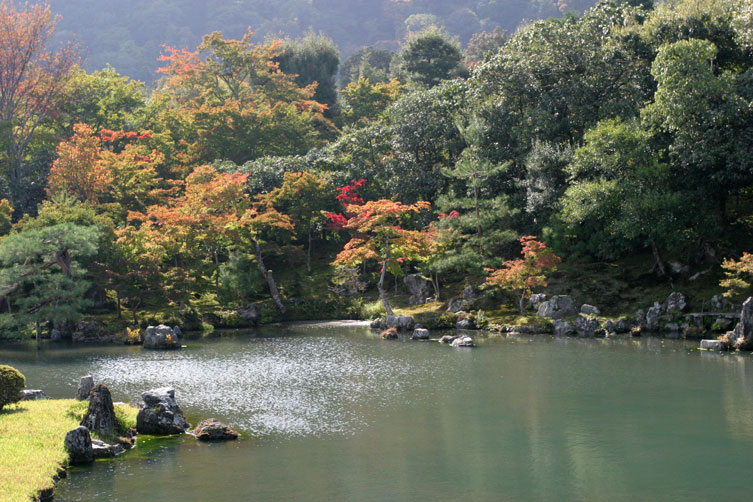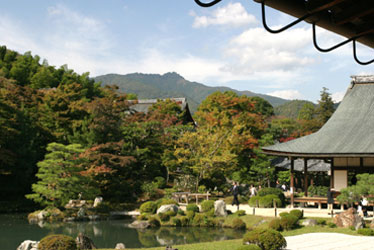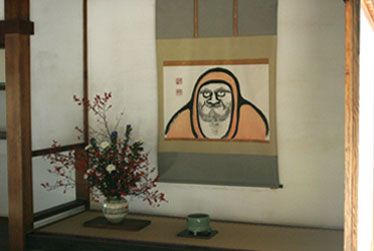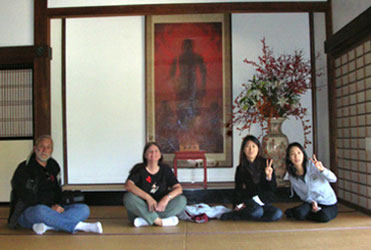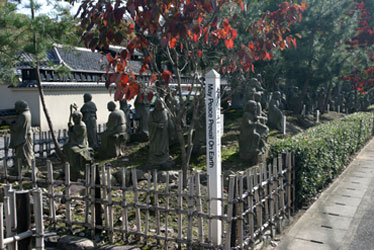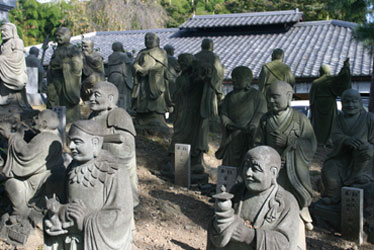Childhood Dreams
Arashiyama
Tuesday was the last day Taeko would be able to spend with us because she had to return to work. Monday had been a holiday in
Japan (Culture Day), and her boss had reluctantly allowed her to take a vacation day on Tuesday. It seems that although Japanese
workers generally have more holiday and vacation days than American workers, it is more difficult for them to take blocks of time off.
Taeko's boss was amazed when she told him that Walt was able to take 2 weeks of vacation for this trip.
Taeko and Izumi arrived at the hotel totting a large shopping bag containing bento lunches that Izumi had prepared. This was
especially surprising considering the late hour we had parted after our long day at Himeji Castle.
We took the train to the Arashiyama-Sagano area in the western hills of Kyoto. Our first stop was the Tenryu-ji
Temple. The temple was built in 1339 after a priest dreamed about a dragon rising from the river nearby. This was interpreted as
a sign that the late emperor Go-Daigo's spirit was uneasy. The temple was built to appease it, and in honor of the inspiration for
the temple's construction, it was named Tenryu which means "heavenly dragon". That, at least, is the fanciful explanation of
the name that I found on several web sites. The brochure distributed at the temple itself simply states that the villa where Go-Daigo
was raised and educated was converted to a Zen temple after he died. In any case, Tenryu-ji has been destroyed by fire and re-built
8 times since its completion in 1343, but the 14th century zen garden that surrounds it is one of the oldest in Japan.
The picture of the field on the left below was taken as we approached the temple.
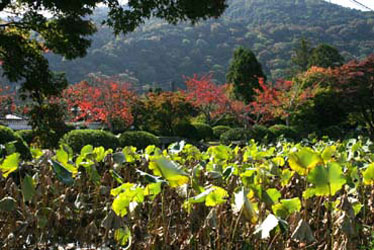

The garden was a lovely, tranquil place, and the pond was full of koi, of course. Here are some pictures.
We spent some time inside looking out at the garden and admiring the objects that were on display. Then we took
the requisite pictures of each other.
After touring the rest of the temple grounds, we headed for a picnic spot along the nearby river. On the way, we passed this
interesting collection of statues nestled in what was essentially a traffic divider. The sign says "May peace prevail on earth."
Here are some pictures of the river and us enjoying our delicious picnic lunch.
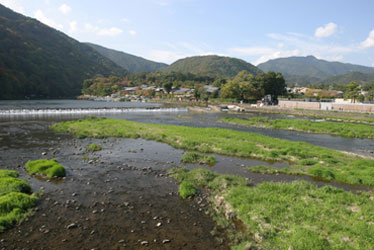
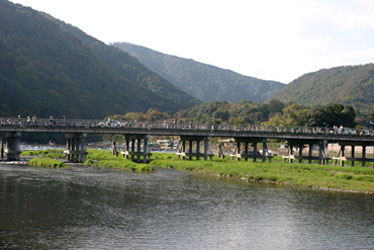


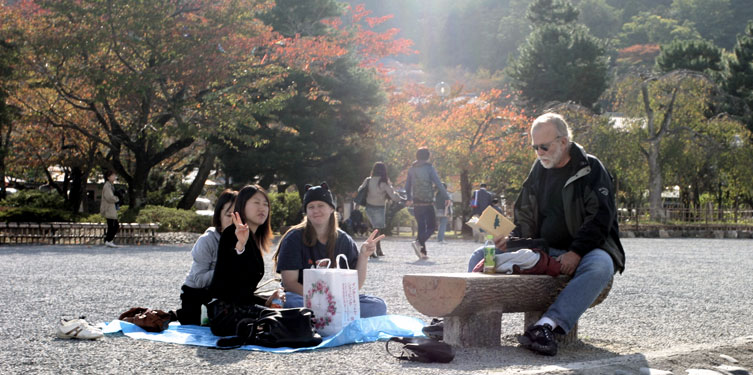
We wandered through the nearby stores and stopped at a small cake shop for some coffee. Green tea is often served
as a complimentary beverage in Japanese restaurants, but I was quite surprised when the solitary cup of coffee I ordered
arrived accompanied by a cup of green tea.
Earlier in the day, we had purchased tickets for the somewhat curiously named "Romantic Train" which travels through a
scenic gorge. The time had come to head for the station so we picked up our leisurely pace.
The train runs along a scenic stretch of the Hozu River and is a popular way to view the spring blossoms and autumn foliage.
One car on the train is completely open so passengers can more fully enjoy the views. Regarding winter, the brochure includes a
picture of the train traveling through the snow and the wonderfully understated text states: "The tram ride during the winter has a
beautiful mood, too. Perhaps due to the cold, passengers are relatively few, and one can thoroughly relish the Hozukyo scenery."
This might be true for visitors from Hokkaido, but I doubt that we would be doing much relishing of the scenery in an open car
dashing through the snow.
Most of our fellow passengers were couples with young children enjoying the warm autumn day. Once again, the
much touted autumn foliage was in short supply, but, nonetheless, the views were beautiful. There are 2 stations along the way
where hikers and bicyclers can disembark on athletic ventures, and it is also possible to cruise down the river on small boats.
It was hard to get a good picture of the train itself, so I scanned the pictures in the first row from the brochure.


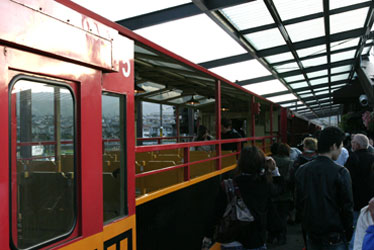

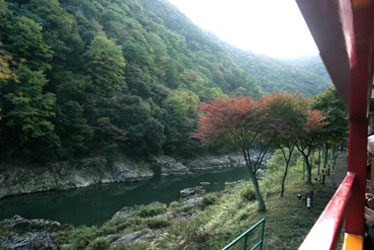
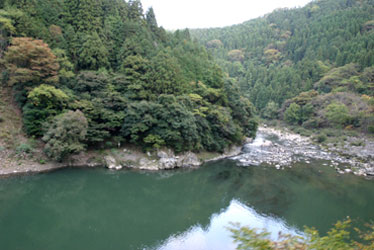
The final station looks out across a plain. It had been quite awhile since we had seen so much open space. The sun was
setting and the temperature was dropping as we walked along the road for about a mile to the nearest JR station and caught
the train back to Kyoto.
Izumi had plans for the evening so we said good-bye to her at Kyoto station, but Taeko decided to stick around a little longer
and have some dinner with us. First, however, we wanted to finally take some time and explore Kyoto station itself. There is a
series of escalators that you can take from the 7th Floor to the Observation Level on the 15th Floor of the building. It's quite a
dramatic ride up. Brightly decorated Christmas trees created a festive atmosphere, and the sound of American Christmas music
filled the air.
Our guidebook said there was a glass corridor at the 11th Floor Level that runs above the main concourse, but I think that must be the
enclosed walkway you can see in the first picture extending out over the Christmas tree, and, if so, it has been carpeted. We imagined
people stepping out onto the corridor and becoming paralyzed with fear when they looked down from such a great height - a sort of
urban version of the glass skywalk at the Grand Canyon.
In the picture on the right in the first row, you can see our hotel - The New Miyako - in the foreground. The picture on the right in
the second row is of the Tokyo Tower Hotel. Many people consider it a blight on the traditional Kyoto skyline, and I must agree that
I found it to be a rather jarring sight when we looked out over the city on the night of our walk through Kodai-ji Temple.
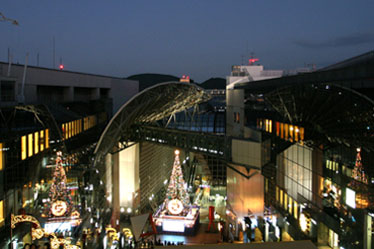
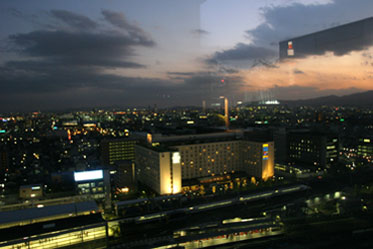
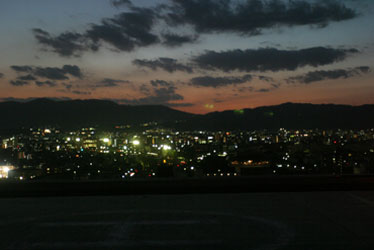

After awhile we went into an underground mall next to the station to search for a place to eat. Long hallways with shop
after shop, restaurant after restaurant stretched before us. We finally settled on a restaurant that served a wide range of pork
cutlets and enjoyed a quiet meal together.
After dinner, as we stood by the escalators to the underground mall talking, we were approached by a young woman who
spoke with Taeko in Japanese. She was interested in starting her own business showing tourists around Kyoto, and she was
asking Taeko if she could interview us. She presented us with a brief questionnaire asking what we had seen and what
sort of tourist services we would use if they were available. She was very pleasant and spoke excellent
English, and we answered her questions in great detail although I'm not sure how helpful our responses were to her because
we're probably not typical American tourists.
The time had come for Taeko to return to her home in Osaka. We had enjoyed our time together immensely and knew
that we would not have had nearly as much fun in Kyoto without her. Although our straightforward attitudes and irreverent comments
probably surprise her at times, she is always a good sport, and she was an invaluable guide during the 4 days we spent
together, tirelessly translating for us and answering our endless questions about the many things we didn't understand.
Izumi is also great fun, and I would like to thank her for the way she always looked out for everyone - checking if they
were tired, making sure everyone had an ample share of the food at the Chinese restaurant in Kobe, and preparing the bento
lunch we had enjoyed earlier in the day.
We would be on our own for the rest of our trip, and we would miss them.


